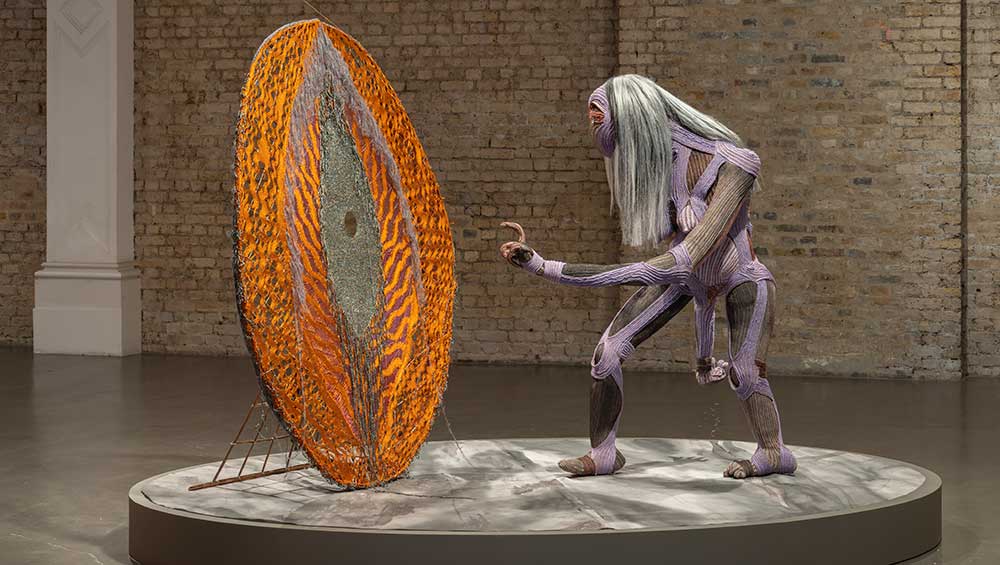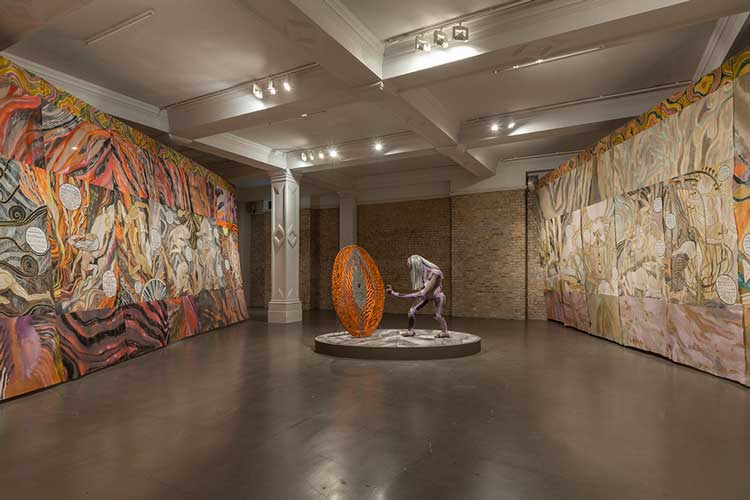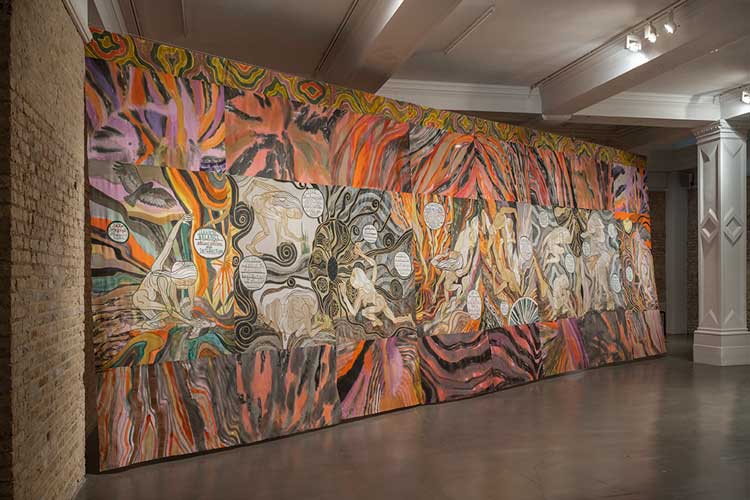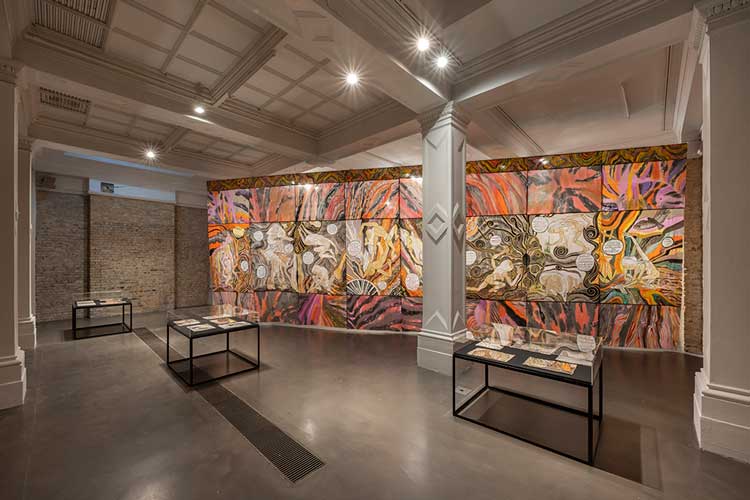
Emma Talbot, The Age/L’Età, Max Mara Art Prize for Women. Installation view, Whitechapel Gallery, London, 2022. © Damian Griffiths.
Whitechapel Gallery, London
30 June – 4 September 2022
by BETH WILLIAMSON
The Max Mara Art Prize for Women, which is awarded every two years, is a collaboration between the Whitechapel Gallery, Max Mara and Collezione Maramotti. Its purpose is to support female artists based in the UK who have not previously had a solo survey exhibition. Emma Talbot was the recipient of this prestigious prize in 2020 when a bespoke six-month Italian residency enabled her to travel through Reggio Emilia, to Rome and to Catania in Sicily. She researched textile craft, permaculture, classical mythology and historic sites and institutions.
The starting point for Talbot’s The Age/L’Età is the painting The Three Ages of Woman (1905) by Gustav Klimt, which Talbot was able to study first-hand. The result is the current exhibition at Whitechapel Gallery, where drawings, animation, three-dimensional work and large-scale hanging painted silk panels come together to reimagine Klimt’s image of an elderly woman holding her head in apparent shame. But there is no shame in Talbot’s images. Here, Klimt’s elderly woman is reinterpreted as the archetypal powerful crone, a wise old woman whose example we might heed.

Emma Talbot, The Age/L’Età, Max Mara Art Prize for Women. Installation view, Whitechapel Gallery, London, 2022. © Damian Griffiths.
Entering the gallery space at the Whitechapel, you are immediately faced by one of two 11-metre-long, free-hanging silk paintings. What you see, however, is the back of the translucent silk hanging with images and words partially visible and in reverse, in a tantalising glimpse that propels you into the middle of the space to see both hangings from the front. Of course, seeing things from behind, from a completely different perspective, is, perhaps, part of Talbot’s point. In front of the silks, you can see the images in their entirety, read the text they contain and follow the story as a strong older woman tackles the modern-day equivalent of the trials of the Twelve Labours of Hercules and attempts to transform contemporary society, addressing some of the most urgent questions of our time. In the centre of the gallery, between the two hangings, is a life-size sculptural figure, formidable, brave and inspirational in equal measure. The figure is constructed from stuffed soft fabric, her thick skin made from knitted fabric, recalling wrinkles and armour. This is Talbot’s protagonist, so what tale does she tell, and how? Well, she might face Herculean tasks, but she does not use Herculean methods. Rather than commit acts of murder and theft to achieve her goals, she uses the core ethical principles of permaculture (care for the Earth, care for people and fair shares), demonstrating an alternative way of existing in the contemporary world and modes of being, even thriving, that embrace care for the climate, feminism and a positive attitude to age.

Emma Talbot, The Age/L’Età, Max Mara Art Prize for Women. Installation view, Whitechapel Gallery, London, 2022. © Damian Griffiths.
Talbot is no stranger to working in painted silk hung in a large-scale spatial installation. What is different in the Whitechapel exhibition is the particular body of research that underpins her work this time. The Italian residency afforded Talbot the time and space to develop her ideas not just in terms of subject matter but in terms of methods and materials. Talbot spent a time at Modateca Deanna with its extensive knitwear archive and knowledge and skills in knitwear production. At various locations in Italy, she had lessons in knitting, discovered a new appreciation of systems of recycling fabric, spent time in fashion and material archives, visited ancient sites, and engaged with ideas of permaculture and sustainability. All this fed into the work in this exhibition in different ways. I was especially taken by her account of a five-hour walk across Mount Etna at dawn and how the volcanic landscape and ruins became the setting for animations and paintings. Talbot taught herself animation during lockdown and her 12-chapter animation captivates the attention for its entire length.

Emma Talbot, The Age/L’Età, Max Mara Art Prize for Women. Installation view, Whitechapel Gallery, London, 2022. © Damian Griffiths.
When it comes to the two large-scale silk hangings that fill much of the gallery space, the strange thing is that, despite their scale, they do not dominate the space or the visitor’s experience. Perhaps that is because of the use of lightweight silk and a flowing narrative. The work does not attempt any authoritative position, it is not framed and hung on the wall, but present within the same space as the viewer. The striated curves and colours across the surface of the silk are reminiscent of the contour lines on a map, recording the information about the territory we are in but leaving it to us to decide which route to take. But who is the older woman in Talbot’s tale? Is it the artist? Is it me or you? Whoever she is, she is not didactic but rather sets up questions and offers guidelines for sustainable living. For instance, the old woman suggests, “Gather in your experience, all the tangled branches of your being” and “Use your agitations to rise up and survive.” She asks: “How will you survive in this climate?”

Emma Talbot, The Age/L’Età, Max Mara Art Prize for Women. Installation view, Whitechapel Gallery, London, 2022. © Damian Griffiths.
None of this is presented as instructional, but as prompts for thought. It encourages questions but leaves everything open for us as viewer to find our own answers. This openness in echoed in the material, too, which is translucent, can be seen from behind, and invites us to walk around it and view it from every angle. The same is true of the sculptural rendition of the old woman. Made from soft material, she is stuffed and shaped to appear strong, somewhat muscular and thick-skinned. Yet the curve of her back and shoulders, along with her hollow tear-dropped eyes suggest someone more vulnerable than she might first appear. To register those various elements of strength and vulnerability in her, we must walk around full-circle and view her from every angle, every point of view. Once again, then, Talbot uses both subject and materials to prompt us to question our place in the world and hers.
Every aspect of this exhibition reveals something further about Talbot’s Italian residency and the role it played in her thinking and making. It is a testament to the importance of prizes such as Max Mara and the sort of residencies it offers that artists such as Talbot are given the time and space needed to think, research and make new work that makes us all think anew.
• The exhibition will travel to Collezione Maramotti in Reggio Emilia, Italy, from 23 October 2022 – 19 February 2023.